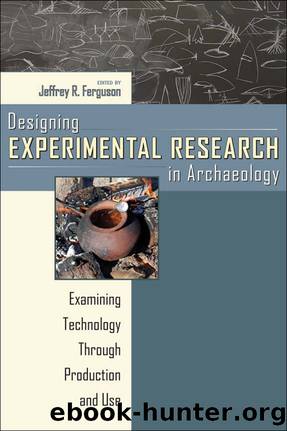Designing Experimental Research in Archaeology by Jeffrey R. Ferguson

Author:Jeffrey R. Ferguson [Ferguson, Jeffrey R.]
Language: eng
Format: epub
ISBN: 9781607320234
Barnesnoble:
Publisher: University Press of Colorado
Published: 2010-05-15T00:00:00+00:00
CONCLUDING THOUGHTS
Our results with Wisconsin orthoquartzites essentially confirm Behm and Faulknerâs (1974) more specific study of the thermal alteration of Hixton silicified sandstone. They found that some subtle physical changes occur in Hixton after heating to 245°C for several hours (Behm and Faulkner 1974). Their conclusion was that the most intensely hued colors of Hixton (dark red, brown, black, and honey) occur naturally but that iron oxides within lighter hues of the raw material may darken the stone as a result of thermal alteration (Behm and Faulkner 1974:273â275). Behm and Faulkner provided no criteria to distinguish between natural and thermally altered materials recovered archaeologically.
Behm and Faulkner (1974:275) could not find any evidence that thermal alteration significantly improved the flaking quality of the Hixton samples, in either hard-hammer or pressure flaking efforts. Some of the samples that were thermally altered became very fragile, and some behaved âdifferentlyâ (Behm and Faulkner 1974:275).
Our study also indicates that heat alteration of orthoquartzite results in few significant changes in the ease or reliability of knapping. It appears that the heating of orthoquartzites at archaeological sites, if truly intentional, was designed to alter the color of the raw material. Also, heating may have been used as a quarrying technique to break up some of the large slabs of raw material, and archaeologically recovered specimens are artifacts of that process, rather than of deliberate heat alteration, in the production of a finished tool (Gregg and Grybush 1976).
Alternatively, further experimentation using higher temperatures may demonstrate that orthoquartzites are possibly enhanced by heat alteration. Rick (1978:18â21) indicates that temperatures of 230â290°C were sufficient to produce color changes but not luster changes in Burlington chert. Temperatures of more than 300°C were necessary for uniform luster changes, but temperatures of 370°C significantly increased the likelihood of raw material burning, decrepitation, and uncontrolled fracturing of material. Replicating our experiments while manipulating controllable variables such as peak temperature and length of heating will provide more complete answers to our questions in the future.
Download
This site does not store any files on its server. We only index and link to content provided by other sites. Please contact the content providers to delete copyright contents if any and email us, we'll remove relevant links or contents immediately.
Born to Run: by Christopher McDougall(7064)
The Leavers by Lisa Ko(6910)
iGen by Jean M. Twenge(5366)
Sapiens by Yuval Noah Harari(5293)
The Kite Runner by Khaled Hosseini(5082)
Spare by Prince Harry The Duke of Sussex(5072)
Machine Learning at Scale with H2O by Gregory Keys | David Whiting(4172)
Bullshit Jobs by David Graeber(4094)
Never by Ken Follett(3787)
Goodbye Paradise(3726)
Livewired by David Eagleman(3682)
Fairy Tale by Stephen King(3216)
A Dictionary of Sociology by Unknown(3024)
Harry Potter 4 - Harry Potter and The Goblet of Fire by J.K.Rowling(2986)
The Social Psychology of Inequality by Unknown(2937)
The Club by A.L. Brooks(2862)
Will by Will Smith(2790)
0041152001443424520 .pdf by Unknown(2784)
People of the Earth: An Introduction to World Prehistory by Dr. Brian Fagan & Nadia Durrani(2701)
